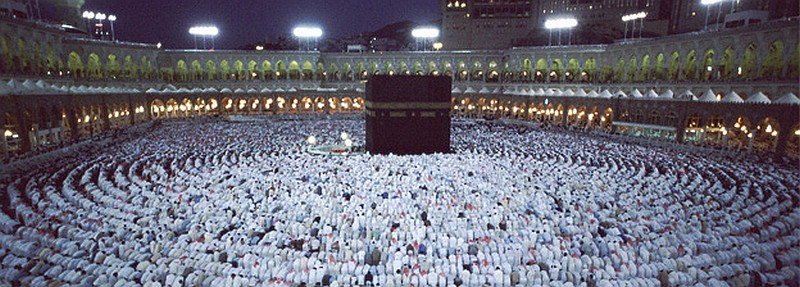The Hajj
By Christopher de Bellaigue
New York Review of Books, April 26, 2012
Edited by Andy Ross
Hajj: Journey to
the Heart of Islam
British Museum, London, England
January 26 to
April 15, 2012
The pilgrimage to Mecca, the Hajj, is the supreme expression of global
Islam. This year more than 2.5 million Muslims will undertake the journey.
The Prophet Muhammad elevated the Hajj into a binding obligation for all
able-bodied believers who can afford it. He laid down five obligations for
Muslims: the declaration of faith, the ritual prayer, giving of alms,
fasting during Ramadan, and the Hajj.
The Hajj is typically conducted
at a high spiritual pitch, with pilgrims describing a transcendent calm
while performing rites alongside countless thousands of others. Many
concentrate on the Ka'aba, the black-draped stone cube at the center of the
Meccan sanctuary, which is believed to have been built by the Prophet
Abraham, and which is the symbolic and physical focus of Islam.
The
pilgrimage is a summons to orthodoxy and a reminder of Islam's ownership of
its origins. The prohibition of non-Muslims from the holy precincts is an
uncompromising assertion of superiority. The guardians of the holy city are
administrators appointed by the House of Saud.
The British Museum
exhibition sets a new precedent in the depiction of Islam in the West. The
exhibits seem to have been selected to help explain the rituals that make up
the Hajj. This approach alerts the visitor to the idea of Islam not as an
art repository but as a living religion.
The Prophet Muhammad
performed the Hajj in 632 CE. That first Hajj is the template for the
pilgrimage that takes place today, during which Muslims affirm their faith,
receive forgiveness for their sins, and relive the efforts of their distant
forebears to please Allah.
Pilgrims begin by going seven times around
the Ka'aba. They approach as close as they can to the black stone within it.
They hurry to and fro along a corridor. They drink from the miraculous well,
Zamzam. Later they pray in a vast multitude on the plain of Arafat. Here
Muhammad preached his final sermon. They hurl pebbles at three stone pillars
representing Satan. They pass hours in prayer and contemplation and
sacrifice an animal.
The exhibition centers on a black cube
reminiscent of the Ka'aba. The names of great cities like Baghdad and
Constantinople lie at the edges of an ivory compass showing the direction to
Mecca from every Muslim region of the world. Pilgrims followed several land
and sea routes during the early centuries of Islam, when Mecca was
controlled by caliphs in Damascus, Baghdad, or Cairo. The Abbasids of
Baghdad built a road linking their capital to Mecca.
The British Museum
enjoyed the cooperation of the Saudi authorities in staging the exhibition.
Since it opened in January, the Hajj exhibition has attracted huge numbers
of visitors. Over 120,000 adult tickets (under-16s get in free) have been
sold at £12 each, with all advance tickets sold out and the museum opening
for longer hours to accommodate the extra demand. Museum director Neil
MacGregor estimates that more than half were Muslim. Many group visits were
organized by the Council of British Hajjis and the Association of British
Hujjaj, both of which help British Muslims perform the Hajj.
AR I shall not travel to London in time to enjoy this exhibition.

